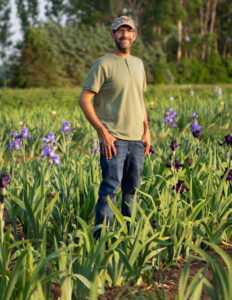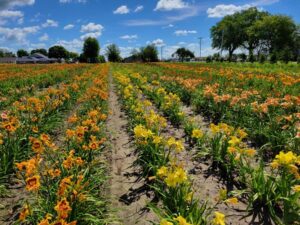Forty Under 40 Perspectives: Keeping fields cleaner
When one of my friends asked me what I did for fun in winter, my wife quickly chimed in and said: “He reads seed catalogs.” I had to pause for a moment, but then realized she was right. I have at least two dozen seed and plant catalogs addressed to my house in any given winter.

I grew up poring over the pictures and descriptions of Wisconsin’s own Jung Seed Catalog. One of the highlights of my middle and high school years was making the hour-long trip each spring from New Holstein to Randolph to buy my Jung seeds. So, when offered the container nursery and field manager role in 2015, I was honored to accept the position. During my interview, the owners stressed the need for two things: keeping the fields cleaner and reducing labor. My first thought was, how do you do both?
KEEPING IT CLEANER
My initial approach to keep the fields cleaner was mechanical. Whenever possible, I had someone on the cultivator knocking the weeds back between the rows. We also used a wiggle hoe to knock the weeds down between plants within the row. A hand-hoe crew followed to get the weeds the equipment left behind.
This approach worked, until I needed my crew for planting or potting, or we had two weeks of rain and the weeds got taller than our equipment could handle. I later added a multivator, a PTO-driven multi-head= tiller, to our equipment line to help with weed control. The multivator chops and kills the weeds rather than dragging them and leaving them in the field to regrow the next time it rains. The combination of multivator and wiggle hoe offered exceptional weed control. The problem was, we had to repeat the process after every rainfall because weed seeds kept germinating all summer. All of those passes over the soil compacted it even more, making our clay soil structure even worse.
My next approach was chemical control. I sprayed the open fields at the beginning of summer to kill the early germinating weeds, then I sprayed again with glyphosate and a pre-emergent to kill the weeds before planting. After planting, I sprayed a third time. This also worked, for a while. I saw some big weeds growing but just left them. If I pulled a big weed, 1,000 other weeds would grow in its place.
Pretty soon, those few big weeds took over and blocked our equipment at harvest time. It also created a plant selection process that benefited tough-to-control weeds such as Canada thistle (Cirsiumarvense), Yellow nutsedge (Cyperusesculentus) and Marestail (Conyza canadensis). Plus, nobody wants to spray that often, especially in the heat of summer. This “scorched earth” approach would also do nothing to help our soil structure and soil health.
Our clay soil continues to bring challenges. I have not yet found an effective cover crop to plant between the rows that does not block up our digging equipment. I now put a cover crop in when a field plot is open. Doing so builds up the soil and helps with weed control. Nature hates a void.
I had five goals for my cover crop. I was looking for something that would hold the soil in place, keep nutrients on the field in the form of plant material, break up the clay with a combination of long roots and the added organic matter, smother weeds by planting something I want growing there, and improve soil health by creating a habitat for mycorrhizae.
My cover crop is a combination of brassicas, tillage radishes and turnips. I chose crops that would winterkill to hopefully avoid a spring herbicide spray. I also want to keep improving our soil health and structure and create a living soil that will work with us rather than fight against us.
Jung Seed Co. grows a large selection of daylily varieties.
Photos courtesy of Joseph Faust.
REDUCING LABOR
After years of trial and error, I found the best IPM strategy is using the right combination of mechanical, chemical and cultural controls. I still use glyphosate pre-plant to control residual perennial weeds and a pair of pre-emergent herbicides (grasses and broadleaves) post-plant, but now I watch and read the soil.
When the pre-emergent is near the end of its efficacy, we run the multivator between the rows, followed by the wiggle hoe and then a hand-hoe crew to get the few weeds missed by the wiggle hoe. After that, I spray a second round of pre- emergent and that is often enough to offer weed control through the growing season.
This approach has allowed me to cut my summer crew in half and has greatly reduced the amount of equipment passed over the field, in turn reducing my labor and fuel costs and soil compaction. Additionally, a combination of compost and cover crops has helped me begin the process of rebuilding beneficial topsoil.











 Video Library
Video Library 


















